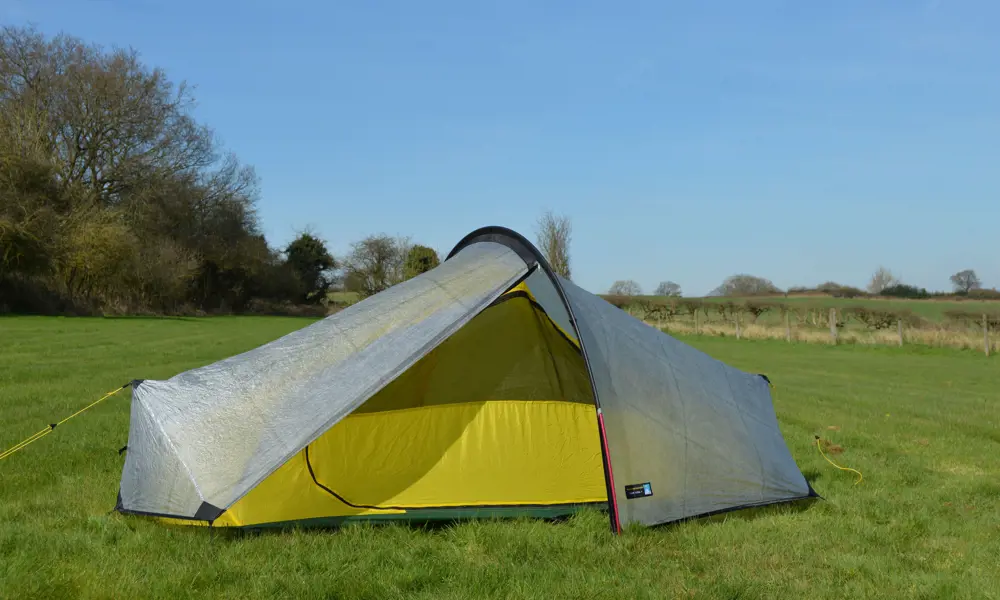
A more convenient way to camp
Andy Utting, a civil engineer and Managing Director of Terra Nova Equipment, set the challenge of producing the world’s lightest tent after noticing a growing demand from solo hikers who wanted to reduce the loads they carried. As an outdoor enthusiast himself, he was also tired of lugging bulky and heavy equipment on overnight trips.
Producing such a lightweight tent required years of experimentation, innovative materials development, refining of manufacturing processes and clever design work. Utting and his team’s first step was to look at the materials they were using. Previously, Terra Nova had established a reputation for producing sturdy mountain tents that withstood nights on end in inhospitable places such as Mount Everest. The team evaluated the tents, and found that the pegs and poles were the heaviest components. Tent pegs alone can weigh up to 300 grams, so swapping to titanium and reducing their size immediately helped to decrease the weight, as did switching to finer zips.
Producing such a lightweight tent required years of experimentation, innovative materials development, refining of manufacturing processes and clever design work
The team attached stress gauges to the tent poles to measure the strain that they were placed under. This revealed that, as the poles were forced into place, they came under extreme loads often well beyond their expected limit. Decreasing the weight of the poles might have helped save weight, but would increase the risk of them breaking as a user wrestled them into place, especially in windy conditions. However, tests showed that by pre-bending certain sections the team could reduce the stress the poles came under. They also used an odd number of poles to ensure that there was no join at the top of the curve where stress would be greatest.
The pre-bent poles could then be made thinner and lighter, but the team also discovered that the strength of a pole was more dependent on the diameter of the tube rather than the thickness of its aluminium walls. By increasing the diameter of the hollow poles by just 0.2 millimetres, they could maintain the strength but reduce weight.
By increasing the diameter of the hollow poles by just 0.2 millimetres, they could maintain the strength but reduce weight
The fabric of the inner and outer skins of the tent were another area that could be transformed. Initially, the team began by reducing the fibre thickness (denier) of the polyester and nylon used to weave the fabrics, but to make the lightest tents in the world, they needed to look for new materials. They discovered that instead of using woven fabrics, they could use a technology more commonly used to make ropes and reinforce body armour – ultra-high-molecular-weight polyethylene.
This thermoplastic can be spun into fibres that are then aligned and bonded together to form thin, flexible sheets. By laminating a single sheet on both sides with a thin polymer film, Terra Nova created super thin and waterproof fabrics. Titanium dioxide, which is often used in suncream, was added to the final coatings to help protect the fabric from damage caused by ultraviolet light.
Terra Nova also changed how the fabric was joined. Sewing tents together adds weight from the thread as well as the layers of sealant needed to ensure that water does not leak through the holes left by the needle. Instead, the team bonded the seams together using tape that is heated to fix two pieces of fabric together. Tests showed that the bonds created in this way are stronger than the fabric itself, so the seams were no longer the tent’s weak point.
These weight-saving innovations culminated in the Terra Nova Laser Ultra 1, a tent that weighs less than a half a kilogram
These weight-saving innovations culminated in the Terra Nova Laser Ultra 1, a tent that weighs less than a half a kilogram. Now, the company is looking towards a new challenge. The current focus of the outdoor industry is to reduce the pack size of equipment too, so Utting and his team are hoping to use their knowledge to create tents that will be not only the lightest, but will also take up the least room when thrown into a backpack for an adventure.
***
This article has been adapted from "A more convenient way to camp", which originally appeared in the print edition of Ingenia 74 (March 2018).
Keep up-to-date with Ingenia for free
SubscribeRelated content
Design & manufacturing

Super cool(er)
Welsh startup Sure Chill has developed a cooler that uses the properties of water to keep its contents cool for around 10 days without electricity. This is ideal for storing items such as vaccines where electricity sources are unreliable.

R&D investment makes good business sense
In just five years, Dr Ralf Speth FREng has presided over a revolution in design and manufacturing that has helped create a new family of engines and has overhauled Jaguar Land Rover (JLR) production facilities.

Steel can arise from the ashes of coal
Thousands of people were laid off in the UK steel industry in 2015 and there are pessimistic future forecasts. Professor Sridhar Seetharaman of the Warwick Manufacturing Group argues that smaller, flexible steel mills implementing new technology would better cope with fluctuating global trends.

Integrating metrology in business and academe
Professor Jane Jiang’s interest in measuring began when she worked on a bus production line in China. She found that the best way to improve quality, consistency and productivity was through metrology, the science of measurement. Today, she runs the UK’s largest metrology research group.
Other content from Ingenia
Quick read

- Environment & sustainability
- Opinion
A young engineer’s perspective on the good, the bad and the ugly of COP27

- Environment & sustainability
- Issue 95
How do we pay for net zero technologies?
Quick read

- Transport
- Mechanical
- How I got here
Electrifying trains and STEMAZING outreach

- Civil & structural
- Environment & sustainability
- Issue 95